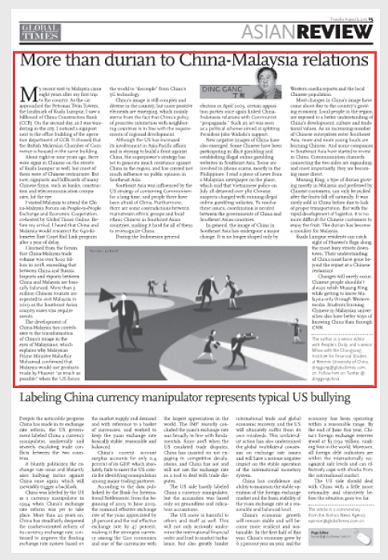Major Power Relations
Your Present Location: PROGRAMS> Major Power RelationsDing Gang: More than durian to China-Malaysia relations
By Ding Gang Source: Global Times Published: 2019-8-7
My recent visit to Malaysia came eight years after my first trip to the country. As the car approached the Petronas Twin Towers, the landmark of Kuala Lumpur, I saw a billboard of China Construction Bank (CCB). On the second day, as I was wandering in the city, I noticed a signpost next to the office building of the operation department of CCB. It showed that the British Malaysian Chamber of Commerce is housed in the same building.

About eight or nine years ago, there were signs in Chinese on the streets of Kuala Lumpur as well, but most of them were of Chinese restaurants. But now, signposts and billboards of many Chinese firms, such as banks, construction and telecommunication companies, hit the eye.
I visited Malaysia to attend the China-Malaysia Forum on People-to-People Exchange and Economic Cooperation, co-hosted by Global Times Online. Before my arrival, I heard that China and Malaysia would resurrect the 640-kilometer East Coast Rail Link program after a year of delay.
I learned from the forum that China-Malaysia trade volume was over $100 billion in 2018, exceeding that between China and Russia. Imports and exports between China and Malaysia are basically balanced. More than 3 million Chinese tourists are expected to visit Malaysia in 2019 as the Southeast Asian country eases visa requirements.
The development of China-Malaysia ties contributes to the transformation of China's image in the eyes of Malaysians, which explains why Malaysian Prime Minister Mahathir Mohamad confirmed that Malaysia would use products made by Huawei "as much as possible" when the US forces the world to "decouple" from China's 5G technology.
China's image is still complex and diverse in the country, but more positive elements are emerging, which mainly stems from the fact that China's policy of proactive interaction with neighboring countries is in line with the requirements of regional development.
Although the US has increased its involvement in Asia-Pacific affairs and is striving to build a front against China, the superpower's strategy has yet to generate much resistance against China in the region, and has created not much influence on public opinion in Southeast Asia.
Southeast Asia was influenced by the US strategy of containing Communism for a long time, and people there have been afraid of China. Furthermore, there are some contradictions between mainstream ethnic groups and local ethnic Chinese in Southeast Asian countries, making it hard for all of them to re-recognize China.
During the Indonesian general election in April 2019, certain opposition parties once again linked China-Indonesia relations with Communist "propaganda." Such an act was seen as a political scheme aimed at splitting President Joko Widodo's support.
New negative images of China have also emerged. Some Chinese have been participating in illicit gambling and establishing illegal online gambling websites in Southeast Asia. Some are involved in phone scams, mostly in the Philippines. I read a piece of news from a Malaysian newspaper on the plane, which said that Vietnamese police on July 28 detained over 380 Chinese suspects charged with running illegal online gambling websites. To resolve these issues, coordination is needed between the governments of China and Southeast Asian countries.
In general, the image of China in Southeast Asia has undergone a major change. It is no longer shaped only by Western media reports and the local Chinese population.
Most changes in China's image have come about due to the country's growing economy. Local people in the region are exposed to a better understanding of China's development, culture and traditional values. As an increasing number of Chinese enterprises enter Southeast Asia, more and more young locals are learning Chinese. And some companies in Southeast Asia have started to invest in China. Communication channels connecting the two sides are expanding, and most importantly, they are becoming more direct.
Musang King, a type of durian growing mostly in Malaysia and preferred by Chinese customers, can only be picked after the fruits fall off naturally. It was rarely sold in China before due to lack of proper transportation. But with the rapid development of logistics, it is no more difficult for Chinese customers to enjoy the fruit. The durian has become a moniker for Malaysia.
Kuala Lumpur residents can catch sight of Huawei's flags along the most busy streets downtown. Their understanding of China must have gone beyond the repast at a Chinese restaurant.
Changes will surely occur. Chinese people shouldn't always relish Musang King while getting to know Malaysia only through Western media. Students learning Chinese in Malaysian universities also have better ways of knowing China than through CNN.
The author is a senior editor with People's Daily, and a senior fellow with the Chongyang Institute for Financial Studies at Renmin University of China.























































































 京公网安备 11010802037854号
京公网安备 11010802037854号





